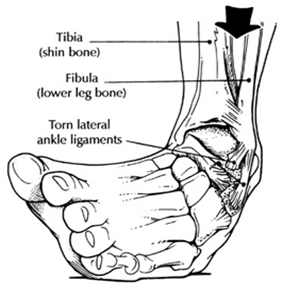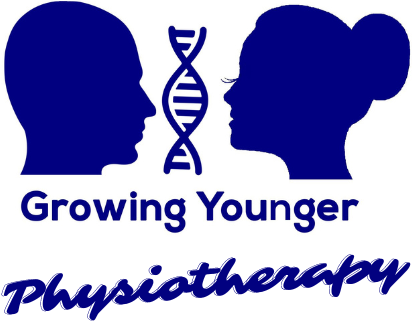What You Need To Know About Your Ankle Injury
Lateral ankle sprains, more commonly known as “a rolled ankle”, are common injuries in both your day-to-day as well as the sporting worlds. As common as they are, these injuries are not as simple to treat as one might think. The foot and ankle, given its importance to your mobility, is a very sophisticated and complex structure with a multitude of supporting ligaments, tendons and muscles.
The way in which a rolled ankle takes place is depicted in the image below. Note how the structures on the outside are over stretched during the roll. It is this over stretching that can strain or tear supporting structures such as ligaments. The most common victim of this type of ankle injury is the Anterior Talo-Fibular Ligament or ATFL for short. In severe cases, the ligament can actually pull off a chip of bone from the Fibula (one of your shin bones) resulting in what’s known as an avulsion fracture. Common signs to look out for if you suspect you might have an avulsion fracture is large puffy swelling which comes on immediately after the injury, in combination with both extreme tenderness to touch in the area and the inability to immediately put weight on the affected foot. If this is the case, it is recommended you go to a medical clinic to get an X-ray and protective crutches or a moon boot. Then book yourself into a physiotherapy clinic – Bodyfit physiotherapy is always here to help.
 If you have been fortunate enough to not have sustained an avulsion fracture, then a strained ligament or tendon is what you are probably going to deal with.
If you have been fortunate enough to not have sustained an avulsion fracture, then a strained ligament or tendon is what you are probably going to deal with.
Tendons and ligaments are not great healers. This is because of their poor blood supply. Left to their own devices these structures will heal slowly. The ligament’s ability to withstand forces placed on it will not be as strong as it was previous to the injury. This leaves it vulnerable to re-injury. Excessive scar tissue is likely to form if the ligament or tendon is not given the right treatment. Based on what is known as Wolffe’s Law of healing, tissues will respond in the manner in which force is applied. This means that an appropriate tensile (or stretching/pulling) force must be applied to the tendon in order to promote proper healing. In other words, specific targeted exercises will provide the ligament with a much-needed controlled tensile force. This will help to guide the healing process.
Balance is also affected after an ankle injury. There are communication lines between the brain and joints which tell you what position your ankle (or other joint) is in relation to your body. This communication is known as “proprioception”. Most ankle injuries affect your proprioception and it is important that this is assessed and addressed. While walking, if something was to cause your ankle to move into an unexpected position, such as an unseen hole or slippery surface, your proprioception mechanism will detect this and allow the body to make immediate adjustments to prevent a fall or injury. Put simple, if your balance is off, you are more likely to re-injury the same ankle again.
How We Can Help Your Ankle Injury Recover Quicker
Physiotherapy aims to speed up healing using electrotherapeutic modalities, therapeutic massage, and specific exercises to improve your muscle strength and sense of balance. As well as that, joint manipulation techniques help to address ankle stiffness. What makes us different is that we look at both specifically your ankle injury as well as the whole kinetic chain. This means that no single body part works in isolation and your ankle injury will have an impact on adjacent joints such as knees and hips. It is important to understand that although the ankle is the only damaged structure, the whole leg is affected. A chain is only as strong as its weakest link. There are several complicating effects of any injury. Most commonly, we will adapt our behaviours to accommodate for pain. We will walk differently, use muscles in ways different from an injury-free person. In its most obvious form this can be referred to as limping. Complications will arise when any structure is either overused or underused. These issues, if left untreated, can become full blown injuries themselves. Have you ever noticed how you sometimes hurt your foot, ankle or knee on one side and after a while your opposite hip starts to hurt? It is therefore essential to take a holistic approach and see the body as a connected working chain.
Following the principle of the kinetic chain, there are also predisposing factors that may leave you more at risk of rolling ankles than other people. Such factors can include muscle imbalances anywhere along the chain, such as stiff joints, tight or weak muscles and/or other untreated old injuries. “Approximately 30% of people who suffer an ankle sprain will sustain recurrent ankle sprains and experience symptoms of pain and instability that last more than 1 year”. [1] The most common reason for this, as discussed earlier, is an incomplete rehabilitation programme from a previous ankle injury. To prevent future ankle injuries, the factors predisposing to re-injury should be identified and addressed effectively.
At Bodyfit physiotherapy we offer a comprehensive assessment and rehabilitation to address all aspects of your ankle injury. We strive to give you the most efficient route to recovery. We also help to identify and manage any predisposing factors. Your rehabilitation will usually be focused on the ankle injury at first. It will then diversify to include a bigger picture as we tailor your program to suit your activity levels, physical capabilities as well as any goals you may wish to achieve.
As always, we use treatment methods that have been proven to be effective in clinical trials. To prevent ankle injuries from coming back we use a balance training programme (including wobble board). A number of clinical studies showed that this type of training can reduce the chances of suffering an ankle injury by more than 70%. [2]
There is also evidence that those people who sprained their ankle in the past will benefit more from this sort of programme than those who never had any ankle pain. So if you recently injured your ankle you are likely to benefit immensely from this treatment.[3]
We also use a form of massage called myofascial therapy. A clinical study done in Spain in 2013 found that patients who receive this form of therapy after an ankle sprain tend to have significantly better outcomes in terms of pain, function and ankle mobility.[4]
If you have just sustained an ankle sprain, as with any musculoskeletal injury, apply the R.I.C.E (Rest, Ice, Compression, and Elevation) principles for the next 48 hours when able. The primary objective of the initial stage rehab is to protect the injury and prevent further damage.
- Rest – to prevent further aggravation of the injury.
- Ice, compress and elevate – to prevent excessive swelling.
In the case of an ankle sprain, wear a compression bandage, apply ice for 20 minutes to the affected area over a wet towel (to protect the skin from possible ice-burn), and elevate the ankle on a foot rest or recliner chair. The next step is the most important. Call us on 09 532 8942 to book an appointment and have a professional look at and take care of your injury.
Here is what our clients say about our services:
“ Very friendly service with a clear and working rehabilitation program” – Robin
So don’t delay! Call 09-5328942 to make your appointment now or make your appointment online by clicking here. Mention this offer during your first visit and we will give you a roll of strapping tape worth $12 absolutely free.
References:
[1] Donovan, L. & Hertel, J. (2012) A new paradigm for rehabilitation of patients with chronic ankle instability. The Physician and Sportsmedicine. 40(4), 41-51.
[2] Holme, E., Magnusson, S.P., Becher, K., Bieler, T., Aagaard, P. & Kjaer, M. (1999) The effect of supervised rehabilitation on strength, postural sway, position sense and re-injury risk after acute ankle ligament sprain. Scandinavian Journal of Medicine & Science in Sport. 9(2), 104–109.
[3] Verhagen, E., van der Beek, A., Twisk, J., Bouter, L., Bahr, R. & van Mechelen W. (2004) The effect of a proprioceptive balance board training program for the prevention of ankle sprains: a prospective controlled trial. The American Journal of Sports Medicine. 32(6), 1385–1393.
[4] Truyols-Domí Nguez, S., Salom-Moreno, J., Abian-Vicent, J., Cleland, J.A. & Fernández-de-Las-Peñas, C. (2013) Efficacy of thrust and nonthrust manipulation and exercise with or without the addition of myofascial therapy for the management of acute inversion ankle sprain: a randomized clinical trial. Journal of Orthopaedic & Sports Physical Therapy. 43(5), 300-9.
